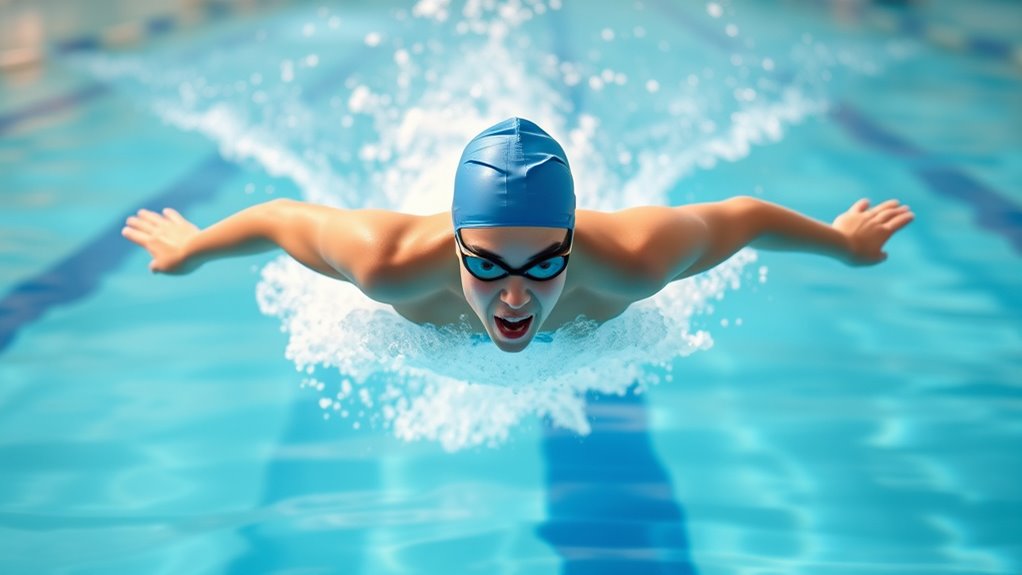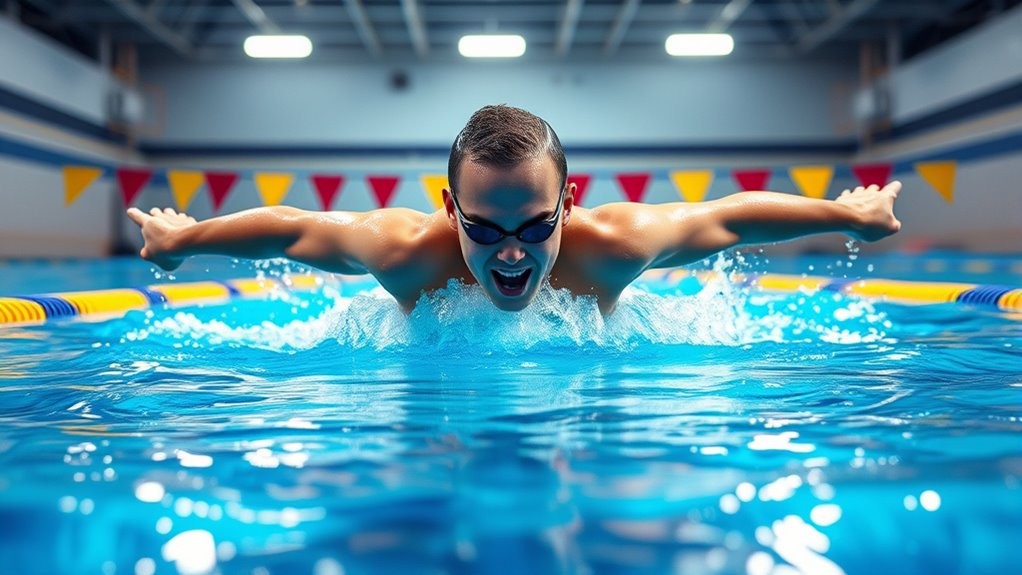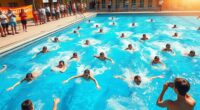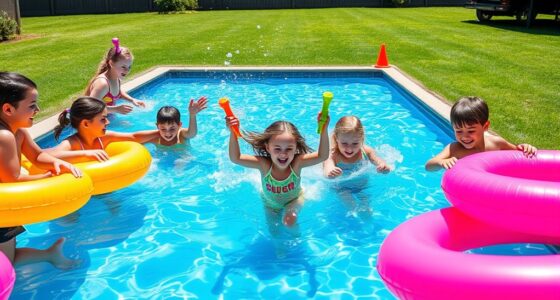To get started with competitive swimming, focus on mastering the four basic strokes: freestyle, backstroke, breaststroke, and butterfly. Keep your body flat and streamlined, coordinate your arm movements with steady kicks, and breathe rhythmically. Proper technique, body positioning, and consistent practice help improve speed and efficiency. Developing good habits early sets a strong foundation, and if you keep going, you’ll discover more tips to elevate your performance even further.
Key Takeaways
- Focus on proper body position to stay streamlined and reduce water resistance during each stroke.
- Learn correct arm movements, entering fingertips first with high elbows for efficient propulsion.
- Maintain steady, gentle kicks from the hips, synchronized with arm strokes for rhythm and momentum.
- Practice breathing techniques that coordinate inhalation and exhalation with stroke timing for smooth airflow.
- Regularly monitor progress and refine technique through drills, feedback, and consistent practice to build endurance and confidence.
Freestyle Stroke Fundamentals

The freestyle stroke, also known as front crawl, is the fastest and most efficient swimming technique. To master it, focus on body position; keep your body flat and streamlined on the water’s surface. Your head should stay in line with your spine, with your face looking down, turning to breathe every few strokes. Your arms move in an alternating, windmill-like motion—reach forward with one arm, then pull back under your body. Your hands should enter the water fingertips first, with a slight angle, then pull through with a high elbow. Your kick, from your hips, should be steady and continuous to maintain balance and propulsion. Proper timing and rhythm between your arm movements and kicks are key to swimming smoothly and efficiently. Incorporating body position awareness can greatly improve your overall technique and speed. Developing an understanding of stroke mechanics can help you refine your movements and become a more efficient swimmer. Additionally, paying attention to breathing technique ensures a consistent oxygen supply and reduces fatigue during your swim. Focusing on coordination helps synchronize your arm strokes and kicks for better efficiency. A strong understanding of water resistance can also help in adjusting your technique for smoother swimming.
Backstroke Technique Essentials

Mastering backstroke requires maintaining a relaxed, streamlined body position while staying on your back with your face above water. Focus on keeping your hips high and your body straight to reduce drag. Your arms should enter the water pinky-first, with a slight angle, then pull back in a smooth, S-shaped motion. Your kick should be steady and continuous, originating from your hips with pointed toes. Breathing is natural—inhale during the arm recovery and exhale underwater. The following table highlights key elements:
| Element | Technique | Tips |
|---|---|---|
| Body Position | Keep hips high, streamline your body | Relax shoulders, avoid sagging |
| Arm Movement | Reach back with fingertips, pull smoothly | Maintain a steady rhythm |
| Kick | Continuous flutter from hips | Keep toes pointed, quick but gentle |
| Breathing | Inhale during arm recovery | Exhale steadily underwater |
| Body Rotation | Slight roll with each stroke | Enhance propulsion and efficiency |
Additionally, focusing on body rotation can significantly improve your swimming efficiency and help conserve energy during your strokes. Incorporating proper body alignment is also crucial for reducing resistance and increasing speed. Developing awareness of body positioning can further enhance your technique and overall performance. Paying attention to core engagement can further enhance your stability and power in the water. Developing consistent technique awareness ensures continuous improvement and prevents inefficient movements.
Breaststroke Key Elements

Have you ever wondered what makes a strong breaststroke? The key elements include a powerful, streamlined pull, a smooth kick, and proper timing. Your arms should sweep outward and then inward, pulling water back efficiently. Keep your elbows high and fingers close together to maximize propulsion. Your kick, often called the “whip” or “frog” kick, involves bending your knees, then quickly kicking outward and together to push water back. Timing is essential—coordinate your arm pull and kick so they flow seamlessly, with your head rising slightly during each stroke for breathing. Maintaining a steady rhythm and focus on streamlined body position to reduce drag helps optimize your stroke. Additionally, understanding the importance of vertical alignment can significantly improve your efficiency in the water. Practicing energetic alignment and mindfulness during each stroke can enhance your overall swimming performance. Being aware of your body’s hydrodynamic shape can further help in refining technique and reducing resistance. Furthermore, paying attention to your body position in the water can lead to more effective propulsion and less fatigue. Mastering these elements helps you swim faster and more efficiently, building a strong foundation for your breaststroke technique.
Butterfly Stroke Basics

Building on your breaststroke skills, the butterfly stroke demands a powerful, synchronized movement of the arms and core. You begin with a strong dolphin kick, using your hips to drive the motion, keeping your legs straight and together. As your arms enter the water, extend them forward, then pull through with a slight bend at the elbows, pulling back to your hips. Simultaneously, lift your head slightly to breathe, then lower it as your arms recover over the water. Maintain a steady rhythm, ensuring your body stays horizontal and streamlined. The key is timing: the kick, arm pull, and breathing must work together smoothly. With practice, this fluid, wave-like motion becomes more natural and efficient. Fostering creativity in a virtual environment can help you develop innovative techniques for refining your stroke efficiency. Consistent practice and technique refinement are essential to mastering this dynamic stroke. Additionally, focusing on your body position helps maintain optimal movement and reduces drag, making your strokes more effective. Incorporating visualization techniques can further enhance your coordination and overall performance, especially when combined with mental imagery to reinforce proper form.
Tips for Developing Good Swimming Habits

Developing good swimming habits starts with establishing a consistent practice routine. You should aim to swim regularly, even if it’s just a few times a week, to build muscle memory and improve technique. Focus on quality over quantity by paying attention to your form and breathing. Keep a training journal to track your progress and identify areas for improvement. Warm up properly before each session to prevent injuries and prime your body for action. Staying mindful of your body position and staying relaxed in the water can significantly enhance your comfort and efficiency. Set achievable goals to stay motivated and avoid burnout. Incorporating training strategies can further enhance your progress and ensure sustained improvement over time. Being aware of your performance cookies can help you understand how your efforts are translating into tangible results. Maintaining proper vase selection for your pool decor can also create a more motivating environment for your swimming practice. Recognizing the importance of development influenced by biological, cognitive, and social factors can help you tailor your training to suit your individual needs and growth.
Frequently Asked Questions
How Do I Improve My Breathing Rhythm in Each Stroke?
To improve your breathing rhythm, focus on timing your breath with your stroke. For freestyle, turn your head smoothly as your arm pulls back, exhaling steadily underwater and inhaling quickly as you rotate. Keep your head low and relaxed, avoiding over-rotation. Practice rhythmic breathing drills, like breathing every three or five strokes, to develop consistency. Over time, this will help you breathe more naturally and efficiently during your swim.
What Gear or Equipment Is Essential for Beginner Swimmers?
Imagine you’re stepping into a modern, high-tech pool in the 21st century. As a beginner, essential gear includes a well-fitting swimsuit, goggles, and a swim cap to protect your hair and improve visibility. You might also want a kickboard and pull buoy to build strength and technique. These tools help you focus on form, breathing, and confidence, making your swim sessions more effective and enjoyable from the very start.
How Can I Prevent Common Swimming Injuries?
To prevent common swimming injuries, you should focus on proper technique, warm up thoroughly, and listen to your body. Make sure to stretch before and after swimming to improve flexibility and reduce strain. Use correct breathing methods, avoid overexertion, and stay hydrated. Incorporate rest days into your routine to allow your muscles to recover. If you experience pain, seek advice from a coach or healthcare professional promptly.
What Are the Best Ways to Overcome Swimming Anxiety?
If you feel anxious about swimming, start by focusing on deep breathing to stay calm. Gradually expose yourself to the water, beginning with shallow areas, and practice relaxing exercises to build confidence. Remember, it’s normal to feel nervous; stay patient and positive. Enlist a supportive buddy or instructor to guide you, and celebrate small progress. Consistent practice will help reduce your anxiety and boost your comfort in the water.
How Long Should I Practice Each Stroke to See Progress?
Think of your progress as planting a seed—you won’t see a sprout overnight. For each stroke, practicing 20 to 30 minutes 3-4 times a week helps you build skills steadily. Consistency nurtures your improvement, so don’t rush. Focus on quality over quantity, and you’ll notice gains within a few weeks. Keep at it, and your confidence and technique will grow stronger with each session.
Conclusion
Remember, practice makes perfect. As you master each stroke and develop good habits, you’ll become more confident and efficient in the water. Keep pushing yourself and stay patient—progress takes time. Don’t forget, every expert was once a beginner. Stay committed, and you’ll see improvement with every splash. As the saying goes, “Rome wasn’t built in a day,” so enjoy the journey and celebrate your progress along the way.









